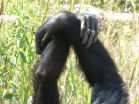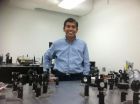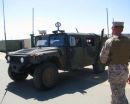(Press-News.org) New Rochelle, NY, August 29, 2012--Biomass recalcitrance--the problem of how to break down complex plant-based cellulosic feedstock into sugars that can be fermented to produce sustainable biofuels and other renewable biobased products—can be overcome through improved methods of biomass characterization. IB IN-DEPTH, a collection of articles from leading research laboratories describing advanced tools and techniques for analyzing the chemistry, structure, and interaction of biomass components, is published in Industrial Biotechnology, a peer-reviewed journal from Mary Ann Liebert, Inc. The articles are available free online at the Industrial Biotechnology website.
The future capability to commercialize large-scale, economical, plant-based biofuels and bioproducts depends on the development of efficient and effective strategies to break down lignocellulosic biomass and to release the carbohydrates that can then be converted into these valuable end-products. Substantial progress is being made in solving the problems of biomass recalcitrance, and Guest Editor Brian Davison, PhD, Chief Scientist for Systems Biology and Biotechnology at Oak Ridge National Laboratory, Oak Ridge, TN, and Science Coordinator for the BioEnergy Science Center of the Department of Energy's Office of Biological and Environmental Research, and a member of the Editorial Board of Industrial Biotechnology, gathered leading researchers to share their work and perspectives.
The special research section includes two Reviews: "Biomass Characterization: Recent Progress in Understanding Biomass Recalcitrance" by Marcus Foston and Arthur Ragauskas, BioEnergy Science Center, School of Chemistry and Biochemistry, Institute of Paper Science and Technology, Georgia Institute of Technology, Atlanta, GA; and "Neutron Technologies for Bioenergy Research" by Paul Langan and colleagues, Oak Ridge National Laboratory, University of Tennessee, Knoxville, and Georgia Institute of Technology. Also featured are Short Communications and Methods articles that present new or improved methods of biomass characterization, including strategies based on biomass accessibility to enzymes, glycomics, polysaccharide changes in plant cell walls, improvements to the Simon's stain technique, an updated method of mechanical stress testing, and a modification of atomic force microscopy.
"Much thanks to Dr. Brian Davison for pulling together this special issue of Industrial Biotechnology," says Larry Walker, PhD, Co-Editor-in-Chief and Professor, Biological & Environmental Engineering, Cornell University, Ithaca, NY. "The development of methods and approaches for characterizing biomass materials is an important step in driving biotechnology development from plant engineering to subsequent conversion to biofuels and bioproducts."
INFORMATION:
About the Journal
Industrial Biotechnology, led by Co-Editors-in-Chief Larry Walker, PhD, and Glenn Nedwin, PhD, MBA, is an authoritative journal focused on biobased industrial and environmental products and processes, published bimonthly in print and online. The Journal reports on the science, business, and policy developments of the emerging global bioeconomy, including biobased production of energy and fuels, chemicals, materials, and consumer goods. The articles published include critically reviewed original research in all related sciences (biology, biochemistry, chemical and process engineering, agriculture), in addition to expert commentary on current policy, funding, markets, business, legal issues, and science trends. Industrial Biotechnology offers the premier forum bridging basic research and R&D with later-stage commercialization for sustainable biobased industrial and environmental applications.
About the Publisher
Mary Ann Liebert, Inc. is a privately held, fully integrated media company known for establishing authoritative peer-reviewed journals in many promising areas of science and biomedical research, including Environmental Engineering Science and Sustainability: The Journal of Record. Its biotechnology trade magazine, Genetic Engineering & Biotechnology News (GEN), was the first in its field and is today the industry's most widely read publication worldwide. A complete list of the firm's 70 journals, books, and newsmagazines is available at the Mary Ann Liebert, Inc. website.
Mary Ann Liebert, Inc. 140 Huguenot St., New Rochelle, NY 10801-5215 www.liebertpub.com
Phone: (914) 740-2100 (800) M-LIEBERT Fax: (914) 740-2101
Biomass characterization technology research highlighted in Industrial Biotechnology journal
2012-08-29
ELSE PRESS RELEASES FROM THIS DATE:
Chimpanzees create social traditions
2012-08-29
A research collaboration between the Gonzaga University and the Max Planck Institute shows that the way in which chimpanzees groom each other depends on the community to which they belong. Specifically, it is the unique handclasp grooming behaviour that reveals this local difference.
The specific behaviour that the researchers focused on was the 'grooming handclasp', a behaviour where two chimpanzees clasp onto each other's arms, raise those arms up in the air, and groom each other with their free arm. This behaviour has only been observed in some chimpanzee populations. ...
Breakthrough in nanotechnology
2012-08-29
A University of Central Florida assistant professor has developed a new material using nanotechnology, which could help keep pilots and sensitive equipment safe from destructive lasers.
UCF Assistant Professor Jayan Thomas, in collaboration with Carnegie Mellon University Associate Professor Rongchao Jin chronicle their work in the July issue of the journal Nano Letters. (http://dx.doi.org/10.1021/nl301988v)
Thomas is working with gold nanoparticles and studying their properties when they are shrunk into a small size regime called nanoclusters. Nanoparticles are already ...
Soaking up the Sun
2012-08-29
Solar panels, like those commonly perched atop house roofs or in sun-drenched fields, quietly harvesting the sun's radiant energy, are one of the standard-bearers of the green energy movement. But could they be better – more efficient, durable and affordable? That's what engineers from Drexel University and The University of Pennsylvania are trying to find out, with the aid of a little nanotechnology and a lot of mathematical modeling.
A three-year grant from the National Science Foundation has set the team on a track to explore ways to make new photoelectric cells more ...
TacSat-4 participates in Navy fleet experiment Trident Warrior
2012-08-29
WASHINGTON –- U.S. Naval Research Laboratory's Tactical Satellite-4 successfully completes three weeks of intense testing, June 28, as part of the Navy's annual Trident Warrior Experiment 2012 (TW12). TacSat-4 is a Navy-led Joint mission that provides Ultra High Frequency (UHF) satellite communications (SATCOM).
Sponsored by Navy Warfare Development Command, Trident Warrior is an annual fleet experiment focused on gaining valuable insights to improve future capability investments. This year's agenda included at-sea experimentation of critical maritime initiatives, and ...
Many trendy 'microgreens' are more nutritious than their mature counterparts
2012-08-29
The first scientific analysis of nutrient levels in edible microgreens has found that many of those trendy seedlings of green vegetables and herbs have more vitamins and healthful nutrients than their fully grown counterparts. A report on the research appears in ACS' Journal of Agricultural and Food Chemistry.
Qin Wang, Gene E. Lester and colleagues point out that microgreens have gained popularity as a new culinary trend over the past few years, especially in upscale markets and restaurants. Those seedlings of spinach, lettuce, red cabbage and other veggies are usually ...
Warning on deterioration of famous Swedish warship, Vasa
2012-08-29
The famous warship, Vasa, displayed in a museum that gets 1.2 million visitors every year and ranks as one of Sweden's most popular tourist attractions, is deteriorating despite ongoing preservation efforts, scientists are reporting. Their study, citing a "significant" loss of strength in the ship's wood, appears in ACS' journal Biomacromolecules.
Ingela Bjurhager, Lars A. Berglund and colleagues explain that the Vasa sunk in the Stockholm harbor in 1628 on its maiden voyage after sailing less than a nautical mile. The ship was rediscovered in 1958, raised in 1961, treated ...
New antibacterial coating for sutures could reduce infections after surgery
2012-08-29
Responding to an urgent need for better antibacterial coatings on surgical sutures, scientists are reporting the discovery of a new coating that is almost 1,000 times more effective than the most widely used commercial coating. Their report appears in ACS' journal Langmuir.
Professor Gregory Tew, who is from UMass-Amherst, and colleagues explain that infection at the site of surgical incisions is one of the most common post-surgical complications that keep patients hospitalized longer and boost hospital bills. The most common antibiotic coating contains triclosan, but ...
A new approach for controlling the skyrocketing cost of health care
2012-08-29
A potentially powerful new approach for limiting health care costs — which account for almost $1 out of every $5 spent in the U.S. each year — is the topic of the feature story in this week's edition of Chemical & Enginering News (C&EN), the weekly news magazine of the American Chemical Society (ACS), the world's largest scientific society.
C&EN Senior Correspondent Marc S. Reisch explains that one until-now neglected way to reign in health care spending involves providing patients and doctors with better diagnostic tests. Such tests could save money by providing greater ...
URI oceanographers find there is one-third less life on Earth
2012-08-29
NARRAGANSETT, R.I. – August 29, 2012 -- Estimates of the total mass of all life on Earth should be reduced by about one third, based on the results of a study by a team of scientists at the University of Rhode Island's Graduate School of Oceanography and colleagues in Germany.
The research was published this week in the Proceedings of the National Academy of Science.
According to previous estimates, about one thousand billion tons of carbon is stored in living organisms, of which 30 percent is in single-cell microbes in the ocean floor and 55 percent reside in land ...
More research needed on the best treatment options for multidrug-resistant TB
2012-08-29
The use of newer drugs, a greater number of effective drugs, and a longer treatment regimen may be associated with improved survival of patients with multidrug resistant tuberculosis (MDR-TR), according to a large study by a team of international researchers published in this week's PLOS Medicine.
Global efforts to control tuberculosis are being challenged by the emergence of strains that are resistant to several antibiotics including isoniazid and rifampicin, the two most powerful, first-line (standard) anti-tuberculosis drugs—so-called multidrug resistant tuberculosis ...


